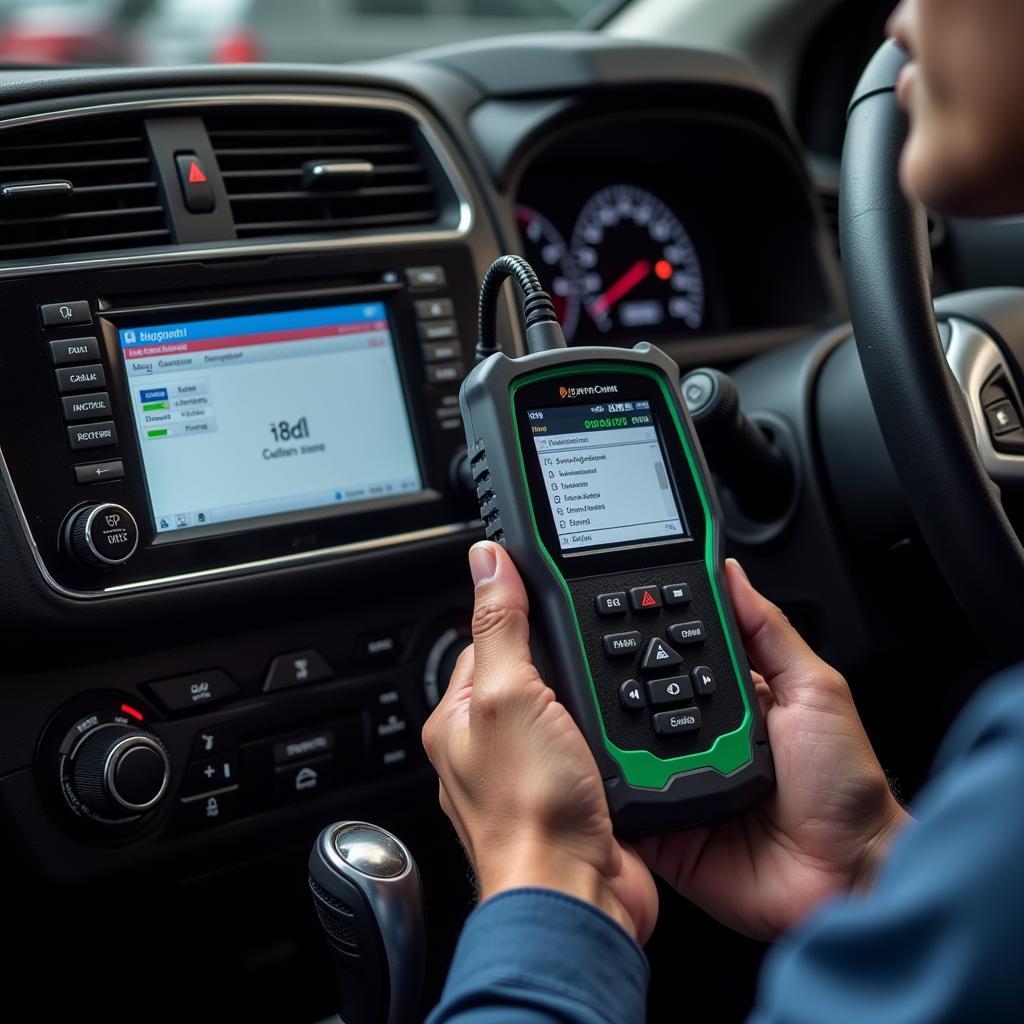The modern vehicle is a symphony of electronics, a far cry from the mechanically-driven machines of the past. With this complexity comes a new era of diagnostics, one where the Uds Diagnostic Tool reigns supreme. But what exactly is a UDS diagnostic tool, and how can it help you, whether you’re a seasoned mechanic or a car enthusiast? This comprehensive guide delves into the world of UDS diagnostics, equipping you with the knowledge to understand and leverage these powerful tools.
Demystifying the Acronym: Understanding UDS
UDS stands for Unified Diagnostic Services, a standardized communication protocol used in the automotive industry. Think of it as a common language that your car’s electronic control units (ECUs) use to talk to diagnostic tools. Before UDS, manufacturers had their own proprietary systems, creating a headache for mechanics who needed a plethora of tools to service different car brands. UDS brought much-needed uniformity, streamlining the diagnostic process.
Why You Should Care About UDS Diagnostic Tools
Whether you’re a professional technician or a DIY car enthusiast, a UDS diagnostic tool can be an invaluable asset. Here’s why:
- Accurate Diagnosis: UDS tools allow you to delve deep into your car’s systems, retrieving detailed fault codes and live data that pinpoint the root cause of issues.
- Comprehensive Coverage: From engine performance to airbag systems, UDS tools offer extensive coverage, communicating with a wide range of ECUs.
- Advanced Functionality: Beyond basic code reading, UDS tools enable functions like component activation, adaptations, and even software updates, providing a comprehensive diagnostic and repair solution.
- Cost-Effectiveness: By empowering you to diagnose and potentially fix problems yourself, UDS tools can save you costly trips to the mechanic.
Choosing the Right UDS Diagnostic Tool: Factors to Consider
Navigating the world of UDS diagnostic tools can be daunting, especially with the wide array of options available. Here’s a breakdown of key factors to guide your decision:
- Vehicle Compatibility: Ensure the tool supports your car’s make, model, and year. Some tools specialize in specific brands, while others offer broader coverage.
- Functionality: Define your needs. Do you require basic code reading or more advanced functions like ECU coding and programming?
- User Interface: Opt for a tool with an intuitive interface, easy navigation, and clear data presentation.
- Software Updates: Regular software updates are crucial to ensure compatibility with the latest vehicle models and diagnostic protocols.
- Budget: Prices vary greatly. Set a budget and weigh the features against the cost to find the best value.
Mastering the Basics: How to Use a UDS Diagnostic Tool
Using a UDS diagnostic tool is generally straightforward, even for beginners. Here’s a simplified guide:
- Locate the OBD-II Port: This standardized port is usually found under the dashboard on the driver’s side.
- Connect the Tool: Plug the UDS tool into the OBD-II port.
- Turn on the Ignition: Turn the key to the “on” position without starting the engine.
- Initiate Communication: Follow the on-screen prompts to establish communication between the tool and your car’s ECUs.
- Access Functions: Navigate the tool’s menu to access desired functions, such as reading fault codes, viewing live data, or performing specific tests.
Beyond Diagnostics: The Expanding Role of UDS
The capabilities of UDS diagnostic tools extend beyond mere troubleshooting. Here are some advanced applications:
- ECU Coding and Programming: Modify ECU parameters to customize vehicle behavior, such as adjusting throttle response or adding features.
- Key Programming: Program new keys and remotes, often a more cost-effective alternative to dealerships.
- Software Updates and Reflashing: Install the latest software versions to improve performance, add features, or fix bugs.
- Advanced Troubleshooting: Access specialized functions like bi-directional control to interact with and test individual components.
A Word of Caution: Responsible Use of UDS Tools
While UDS diagnostic tools are incredibly powerful, it’s crucial to exercise caution. Inexperienced users should avoid making any modifications beyond basic diagnostics. Improper use can potentially damage your vehicle’s sensitive electronics. When in doubt, consult with a qualified mechanic or seek professional assistance.
The Future of Diagnostics: UDS and Beyond
UDS has revolutionized automotive diagnostics, bringing standardization and advanced functionality to the forefront. As vehicles become increasingly complex, UDS will continue to evolve, paving the way for even more sophisticated diagnostic and repair solutions. The future holds exciting possibilities, from remote diagnostics to predictive maintenance, all powered by the ever-evolving world of UDS.
install graphics diagnostics tools
Expert Insight: Real-World Perspectives on UDS
“UDS diagnostic tools have been a game-changer for my workshop,” says John Smith, a certified master technician with over 20 years of experience. “The ability to accurately diagnose complex electronic issues and perform advanced functions like ECU coding has significantly improved our efficiency and customer satisfaction.”
UDS Diagnostic Tools: Empowering Car Owners and Professionals Alike
From demystifying cryptic fault codes to unlocking hidden vehicle features, UDS diagnostic tools are essential for anyone who wants to delve deeper into the inner workings of their car. Whether you’re a professional seeking to enhance your diagnostic capabilities or a car enthusiast eager to take control of your vehicle’s health, understanding and utilizing UDS tools is a wise investment.
Frequently Asked Questions
1. Are UDS diagnostic tools universal?
While UDS is a standardized protocol, not all tools support all car makes and models. It’s crucial to choose a tool compatible with your specific vehicle.
2. Can I use a UDS diagnostic tool to clear fault codes?
Yes, most UDS tools allow you to clear fault codes once the underlying issue has been resolved. However, simply clearing codes without addressing the root cause is not recommended.
3. Do I need a high-end UDS diagnostic tool for basic DIY use?
Basic UDS tools designed for DIYers are available and can provide sufficient functionality for reading and clearing codes, viewing live data, and performing simple tests.
4. Can I update the software on my UDS diagnostic tool?
Most reputable UDS tool manufacturers provide regular software updates to ensure compatibility with new vehicle models and diagnostic protocols. These updates are often available for download from the manufacturer’s website.
5. What are some common applications of UDS diagnostic tools?
Common uses include reading and clearing fault codes, viewing live data, performing component activations, conducting adaptations, installing software updates, and programming keys.
6. Are there any risks associated with using a UDS diagnostic tool?
While generally safe when used responsibly, improper use of a UDS tool can potentially damage your vehicle’s electronic systems. Always refer to your vehicle’s service manual and proceed with caution when performing advanced functions.
7. Where can I get help using my UDS diagnostic tool?
Many online forums and communities are dedicated to automotive diagnostics and can offer valuable support and guidance. Additionally, most tool manufacturers provide customer support channels to assist with any questions or issues.
For expert assistance and a wide range of UDS diagnostic tools, contact ScanToolUS at +1 (641) 206-8880 or visit our office at 1615 S Laramie Ave, Cicero, IL 60804, USA.



